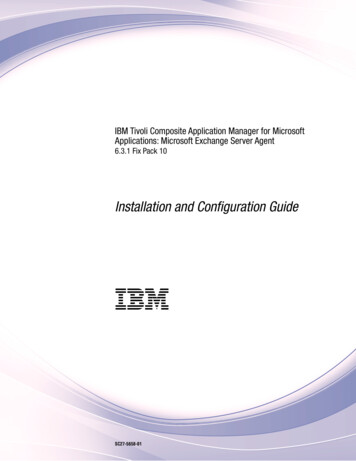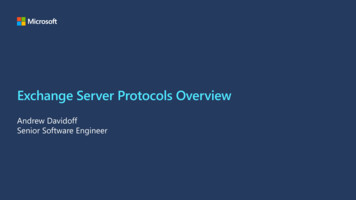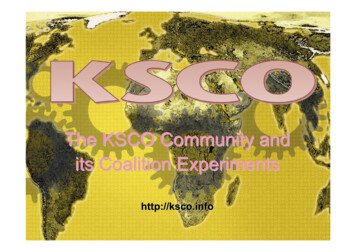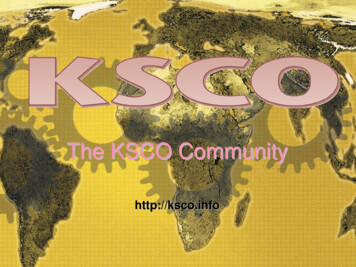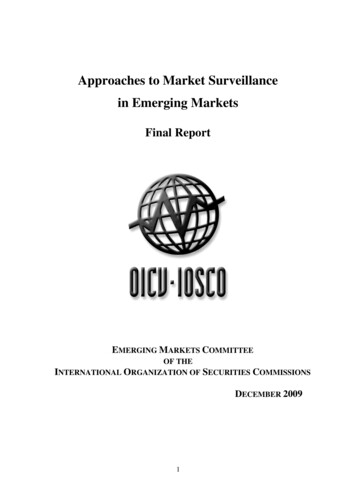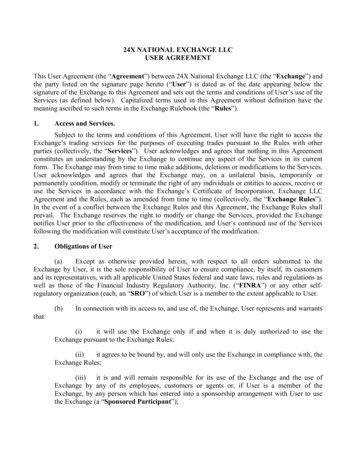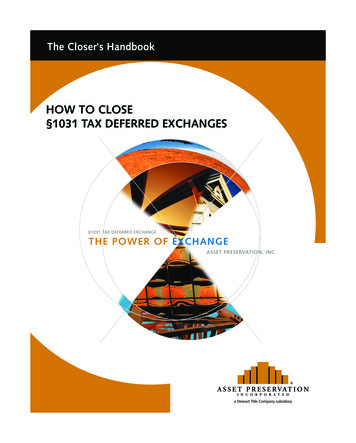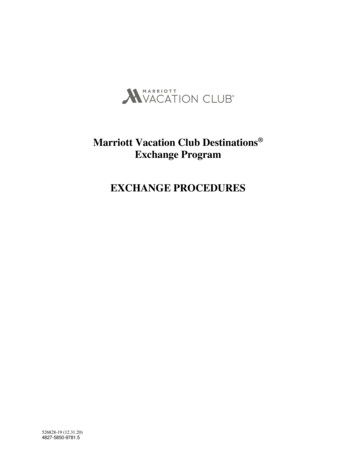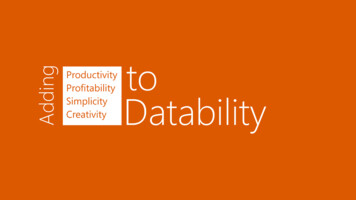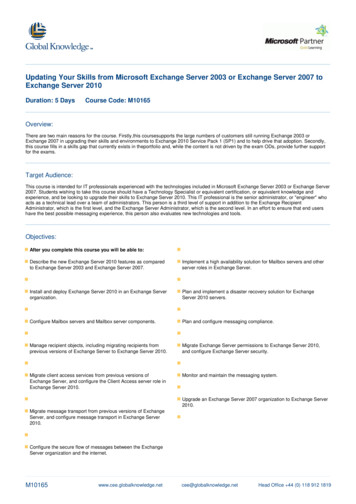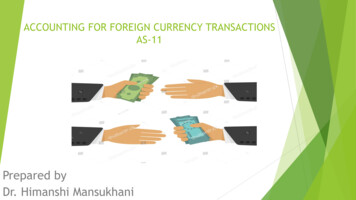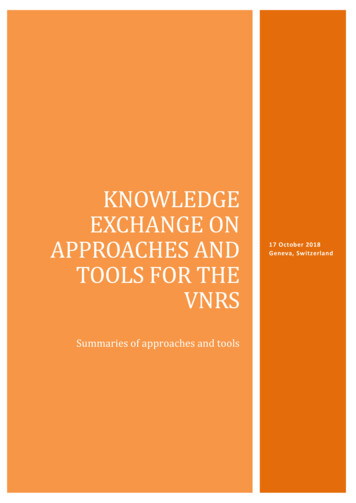
Transcription
KNOWLEDGEEXCHANGE ONAPPROACHES ANDTOOLS FOR THEVNRSSummaries of approaches and tools17 October 2018Geneva, Switzerland
ContentsAfrican Peer Review Mechanism (APRM) . 3CSEND, Geneva . 3Development Initiatives. 3Equal Measures 2030 . 4Global Network of CSOs for Disaster Reduction (GNDR) . 4ILO . 5INTOSAI . 6International Women's Rights Action Watch Asia Pacific (IWRAW AP), RESURJ . 6Millennium Institute . 7OECD. 7Partners for Review. 8The Partnering Initiative (TPI) . 9UNDP . 9UNESCO . 10UNHCR . 11UNITAR . 11UNFPA. 12United Nations Foundation (UNF) . 13United Nations Global Compact . 13United Nations System Staff College (UNSSC). 14UN Volunteers (UNV) . 14UN-Water . 15World Business Council for Sustainable Development (WBCSD) . 15Participants list . 162
African Peer Review Mechanism (APRM)APRM Electronic QuestionnaireThe APRM Electronic Questionnaire Tool is an APRM initiative developed to assist AfricanCountries in gathering information unique to Africa and African Union initiatives. The tool isdesigned to allow the APRM and all Member States with gathering information and data relatingto any topic or aspect as and when required. The APRM electronic questionnaire is available toall APRM Member States and organisations within the African continent to be used when the needarises to collect data, conduct questionnaires/surveys or need to gauge opinion either in a specificsector or in general. The main objective of the electronic questionnaire is to simplify datacollection processes, support a wide range of surveys and opinion polls, provide real-time data,compare historical and current statistics, generating and managing results time-efficiently, lessprone to human error, more secure and at the comfort of both the Member Countries and ReviewMission Teams.CSEND, GenevaConnecting SDG 11, 16 & 171. Investment in physical and social infrastructure projects are needed to implement theSDGs (AAAA 2015).2. SDG 11 (urban development) requires sustainable financing, sustainable governance andcompetent project management3. Implementing SDG 11 requires SDG 16.6 (Develop effective, accountable and transparentinstitutions at all levels) and SDG 16.7 (Ensure responsive, inclusive, participatory andrepresentative decision-making at all levels).4. Financing infrastructure can be done through governments’ own means; publicprocurement; PPPs (SDG 17.17); concessions or privatization of services.5. The choice of financing depends on a government’s ability to collect taxes (individual andcorporate taxes), VAT, PPPs or by borrowing from development banks and partnercountries6. If financed through borrowing, the borrowed money has to be paid back. If by means ofPPP- the next generation has to pay back the loan hence inter-generational justice has tobe secured.7. Sustainable infrastructure design criteria are available (Saner, 2016) and sustainableimplementation of SDG 16.6 and 16.7. can be strengthened through ISO 18091andcapacity building (training) through ISO 10015Development InitiativesDevelopment Initiatives (DI) is an independent international development organisation thatfocuses on the role of data in driving poverty eradication and sustainable development. The3
objective of our P20 approach is to focus attention on the poorest 20% both globally and in everycountry as a practical way of driving (and measuring) progress on the Agenda 2030 commitmentto Leave No One Behind. We launched the P20 baseline report at the 2017 HLPF, proposing thatannual progress on LNOB could be tracked using a small number of bellwether indicators drawnfrom the SDG framework - income, nutrition and birth registration. Our data analysis showed thatthe global P20 - the poorest 20% of women, men and children in the world - have just 1% of globalincome, account for 46% of stunting in the under-fives and have 55% of all unregistered births.This year, we were funded by SDC to pilot the use of the P20 concept in two countries submittingVNRs to the 2018 HLPF, Switzerland and Benin. The outcome of our analysis was shared at a sideevent at HLPF, at which we launched an interactive pdf with profiles on how the P20 are doing inevery country across the world based on best available data. We believe that this approach couldbe adopted by any country undergoing a VNR and would welcome the opportunity to showcaseour work to date at this event.Details of our global P20 report, our reports on Benin and Switzerland, and our interactive pdfare all available on our website: www.devinit.org/p20i/Equal Measures 2030Equal Measures 2030 (www.equalmeasures2030.org) is a global partnership of civil society andprivate sector organisations that have united to ensure that data and evidence drive change ongender equality in line with the SDGs. Several of our partner organisations are members of theMajor Groups, including the International Women's Health Coalition, FEMNET, and ARROW (allpart of the Women's Major Group).Our partnership has recently launched a new SDG Gender Index, to track progress on the genderequality dimensions of the SDGs. The SDG Gender Index is currently in pilot form, with data forsix countries now available. The Index will be refined in response to feedback up until December2018 before it is launched with data for as many countries across the world in 2019. The SDGGender Index has received positive feedback from government representatives in many of the sixcountries. The SDG Gender Index is the first tool we could share. Information on the SDG GenderIndex can be found in our new report Data Driving Change, available here:http://data.em2030.org/global-report/ (see also the Data Hub below)The second tool is a new Gender Advocates Data Hub. It is available at http://data.em2030.org.The Data Hub has the results of our SDG Gender Index, but also compiles other data, evidence andstories related to gender equality and the SDGs. It is organised by SDG and also by country (withthe six countries included in the pilot available now).Global Network of CSOs for Disaster Reduction (GNDR)The Global Network of Civil Society Organisations for Disaster Reduction (www.gndr.org) is thelargest international network of organisations committed to working together to improve thelives of people affected by disasters world-wide. Its members are committed to increasecommunity resilience and reduce disaster risk around the world.4
GNDR has conducted regular local level monitoring of progress in resilience since 2009, reaching89,000 stakeholders across 129 countries. This monitoring exercise, conducted in 2009, 2011,2013, is known as Views from the Frontline (VFL) and it is currently in its 2019 iteration. VFL2019 covers forward-looking actions focused on strengthening resilience capabilities. It isimplemented in 50 countries across the world, many of which have committed to producing aVoluntary National Review of SDGs for 2019. It aims at establishing a local baseline andmonitoring process to measure progress towards achieving an inclusive “people-centred”approach to resilience-building, as promoted within the 2030 Agenda, the Sendai Framework forDRR, and other frameworks.VFL 2019 takes a systems-wide perspective that recognises different actors have different butrelated responsibilities at different administrative levels.Local-level interviews are complemented by survey questions targeting key informants workingon the sub-national/national institutional and political environment. Questions on the “enablingenvironment” are designed to increase awareness and assess progress on wider institutionalfactors essential to scale out local action, putting a political spotlight on gaps and challenges to beaddressed in through mutually-reinforcing actions by different actors at different scales. Thewhole process is led by local actors themselves, building their capacity to monitor and utilise localrisk information.A VFL Pilot was implemented in 2018 in Tonga and the Philippines, to test the methodology thatis now being used in other 48 countries. After regional, national and local training, communityfacilitators and enumerators conducted the VFL surveys and structured conversations withcommunity residents, vulnerable groups, local government and CSO representatives, for a totalof 3,400 respondents (900 in Tonga and 2,500 in the Philippines). Data from the pilot project willsoon be available online; collection and analysis of data for the other 48 countries will start inearly 2019.ILOThe ILO Department of Statistics’ main activities are data collection and dissemination,leading the international standard setting process and providing technical cooperation andtraining, all in the field of labour statistics. ILOSTAT, the ILO’s central labour statisticsdatabase, is the consolidation of these efforts, presenting a comprehensive set of statistics tomeasure and monitor decent work and the labour-related SDGs and giving easy access totimely labour statistics on numerous topics and with many disaggregation’s in accordancewith the SDG global indicator framework. Through the use of standard or recommendedmethodologies, ILOSTAT aims to ensure data quality and comparability.The ILO MULTILATERALS Department has developed a support and training tool namedDecent Work for Sustainable Development (DW4SD) Resource ang--en/index.htm). The web-based interactiveplatform is intended to support constituents, ILO staff, UN country team members, developmentpartners and other stakeholders in their efforts to adequately situate the concept of Decent5
Work in national processes aimed at translating the 2030 Sustainable Development Agendainto national plans, programmes and budgets, including the formulation of next generationDecent Work Country Programmes, UNDAFs and MAPS processes (Mainstreaming,Acceleration and Policy Support) and VNRs. The structure of the DW4SD Resource Platformconsists of 24 thematic areas. Each thematic area provides the user with backgroundinformation, relevant SDG targets and ILO policy outcomes and a discussion guide. Theassociated resource library includes good practice models, relevant international labour standards,SDG target indicators, and tools and services related to the thematic area.INTOSAIAUDITING THE SDGs: ROLE of INTOSAI1INTOSAI Crosscutting Priorities “Contributing to follow-up and review of SDGs within context ofeach nation’s specific sustainable development efforts and SAIs’ individual mandates.”4 approaches for SAIs’2 valuable contributions to implementation of SDGs:I.II.III.IV.Assessing readiness of national systems to implement SDGs;Performance audits on government programs contributing to SDGs;Assessing and supporting implementation of SDG 16SAIs being models of transparency and accountabilityINTOSAI programs: “Auditing Implementation of SDGs” supporting 70 country SAIs in SDG performanceaudits for whole of government approachIn 2019 publication of compendium on central audit findings2016, 2018 and 2019 INTOSAI Side Events at HLPF on SAI contribution to ensuring thatno one is left behind in SDG implementation and on experiences of SAIsPublication of SDG audit reports on INTOSAI websiteInternational Women's Rights Action Watch Asia Pacific (IWRAW AP), RESURJIWRAW Asia Pacific (https://www.iwraw-ap.org/) is an international women's rightsorganisation rooted in the Global South. We have been monitoring the work of treaty bodies andfacilitating NGO engagement with the CEDAW framework and review process for 25 years andcounting. We work in partnership with women human rights defenders and women’s rightsorganizations, especially those from the Global South and those representing marginalizedgroups of women, to drive the implementation of a progressive women’s human rights agendalocally and globally.12INTOSAI - International Organization of Supreme Audit InstitutionsSAI - Supreme Audit Institutions6
To make sure that the implementation of the sustainable development goals is centered onhuman rights and does not widen existing inequalities, we have developed a tool(http://bit.ly/cedaw-sdgs) to identify practical ways of linking the human rights framework andthe sustainable development framework. While our focus is on CEDAW and the SDGs, this toolcan be used to make links between any human rights instrument(s) and the SDGs. Some of theways to use the links made using this tool are to: Identify interlinkages between SDGs including corresponding human rights standardsPrepare reports for VNRs that are centered on human rights obligations of statesIdentify concrete ways of operationalizing gender as a crosscutting issue across theagendaIntegrate SDGs into reports developed within the human rights framework, including totreaty bodies and the UPRUse the SDGs as a tool to accelerate progress towards achieving state human rightsobligations, especially towards women and other marginalized groups of peopleInfluence the development of SDGs indicators, especially at national level, that integraterelevant human rights standards and obligationsMillennium InstituteiSDG – Integrated Sustainable Development Goals ModeliSDG is an interactive policy simulation tool that tracks the dynamic interactions between keysocial, economic and environmental drivers of sustainability, to reveal alternative paths towardsthe SDGs. This makes iSDG particularly useful for policymakers who have to design developmentstrategies and investment plans for achieving the SDGs. iSDG can be customized to a country,region, or city, in partnership with local experts to capture their distinctive characteristics.Through a user-friendly interface, iSDG can be used in stakeholders’ workshops to collaborativelyevaluate multiple policy interventions and identify synergies, trade-offs, and high-impactintervention points. This promotes policy coherence across the 17 SDGs and identification of costefficient, sustainable solutions. Other benefits include: Alignment of existing or new development plans with the SDGs.Prioritization and sequencing of policies needed to achieve the SDGs.Estimation of the investments needed to implement interventions.Identification of financing options, including co-financing and blended finance.OECDMeasuring Distance to SDG Targets StudyThe OECD Statistics Directorate developed a Study on Measuring the Distance to the SDG Targets,aimed at assisting countries with national implementation of the 2030 Agenda. The Study drawson the UN IAEG Global List of Indicators, providing a high-level overview of strengths and7
weaknesses by assessing the distance that countries need to travel to meet each target, and amapping of the data gaps and statistical agenda ahead in view of the SDGs.An update of the Study will be published in March 2019, with expanded indicator, target andcountry coverage. The Study update will also explore issues relating to monitoring progress onSDGs, such as identifying transboundary effects within the 2030 Agenda, as well as trackingprogress over time and assessing trends based on historic data. The Study used to supportindividual member countries in aligning strategies with SDGs and in Voluntary National Reviews.Additionally, a recent working paper contributes to the aim of “leaving no-one behind” byassessing progress on SDGs for children and youth.Global Hub for the Governance of the SDGsAchieving the SDGs will require governments to coordinate, consult and work across policy areas.It will entail the strategic use of budget, procurement and regulatory tools and the design andimplementation of innovative, forward-looking policies and programmes. The OECD, incollaboration with a number national governments and the UN System, seeks to launch a GlobalHub on the governance of the SDGs as an innovative and practical way of helping countries intheir efforts to strengthen their governance arrangements for the implementation of the SDGs.The Hub, planned to launch at the 2019 HLPF, will help bring together expertise and mobilisemuch-needed support for the implementation of the SDGs, and to facilitate targeted assistance indeveloping and developed countries worldwide in these critical governance areas and could beused by countries in their VNR processes. The Hub will rely on tools and practices that have beendeveloped based on experiences in the area of public governance across OECD and non-OECDcountries, such as a role of centres of government, system approaches, policy coherence forsustainable development, budget process and aligning resources, including gender and greenbudgeting, regulatory framework, innovation in the public sector, integrity and fightingcorruption, public procurement, open government including open data as well as strengtheningpeople-focused justice delivery to ensure equal access to justice for all.Partners for ReviewPartners for Review brings together representatives of the state, civil society, the private sectorand academia to reflect on, discuss and share their experiences regarding review and follow-upto the 2030 Agenda for Sustainable Development. The program initiates networking betweenstakeholder groups from countries that have already presented their reviews at the HLPF andthose that are currently preparing to do so. A learning and sharing network enables detailedexperiences of review and follow-up at national level to be analysed and disseminated, andrecommendations to be formulated for shaping subsequent stages in the process. The networkthereby focuses on i) institutional mechanisms for effective review, ii) meaningful engagement ofnon-governmental stakeholders, and iii) data and statistics. Lessons learned andrecommendations made are relevant to the national review process but also to shaping thereview process within the HLPF.8
The Partnering Initiative (TPI)Founded in 2003, The Partnering Initiative (TPI) is an international agency dedicated tounleashing the power of partnership for the SDGs. TPI works with all societal sectors as well asglobal and national partnerships, offering a range of tools and approaches to mainstream effectivepartnering, including:1) Partnership catalysing platforms: Development of in-country, in-person platforms tosystematically engage business as a partner in delivering the SDGs. The platforms convenebusiness, government, UN and civil society around key SDG issues, innovate ideas for valuecreating collaborations and directly support the development of partnerships.2) Fit for Partnering: Supporting organisations to excel at partnering and maximize theirimpact through building their institutionally capability to partner: developing a partneringstrategy; partnership-optimized internal systems and processes; staff capacity, support andinternal guidance; and a pro-partnering culture.3) Professional development: Building the mindset, skills and technical partnering knowledgethrough training courses and coaching, supported by a range of tools and guidebooks.4) Partnership support: Design and facilitation of partnerships; evaluation and review;troubleshooting and optimization; case study development.UNDP SDG 16 Reporting GuidanceTool which helps Member States draft an SDG 16 chapter in their VNR. Led by UNDP, underthe umbrella of the Global Alliance for Reporting Progress on Peaceful, Just and InclusiveSocieties. Finalized by November. SDG 16 monitoring pilot methodologyThree-step pilot methodology and Community of Practice of countries seeking support tomonitor progress on SDG 16 at the national level. Two pilot countries (El Salvador andUruguay) have already used the methodology to draft SDG 16 chapters for their VNRs in 2017.Details: pilot report Rapid Integrated Assessment (RIA) ToolTool that helps countries assess their readiness to implement the SDGs. It maps currentDevelopment Plans and sector strategies and provides an indicative overview of the level ofalignment between the them and SDG targets. It also identifies the potential need for multisectoral coordination. Details: RIA – Rapid Integrated Assessment Tool ‘Leave no one behind’ (LNOB) FrameworkFramework proposes five factors to understand who is being left behind and why:discrimination; place of residence; socio-economic status; governance; and vulnerability toshocks. The factors can be applied using a three-pronged approach: to examine thedisadvantages people face in and across the five factors; empower those who are being left9
behind (or who are at risk of being left behind); and to enact inclusive, far-sighted andprogressive SDG policies. Details: LNOB FrameworkInternational Futures Global Forecasting tool (IFs)Computable general equilibrium (CGE) model by the Pardee Center at University of Denver,consists of 12 interlinked modules/systems to provide analytical insights on the benefits ofcountry reforms, SDG interventions or shocks. As part of UNDP’s collaboration with PardeeCenter, the model also contains an SDG module allowing the user to track progress on severalSDG indicators and targets from policy interventions. Details: IFs - International FuturesGlobal ForecastingUNESCOHosted by UNESCO, the SDG-Education 2030 Steering Committee encourages governments toreport publicly on progress towards national education policy goals on a regular basis. Suchreporting can be used as key sources for the education section of their SDGs Voluntary NationalReviews (VNRs). The Steering Committee support countries to monitor progress towardsEducation 2030 targets through UNESCO's Institute for Statistics (UIS) and the GlobalEducational Monitoring (GEM) Report. Specific tools include: World Inequality Database on Education (WIDE)The 2017 edition of the SDG 4 Data Digest entitled The Quality Factor: StrengtheningNational Data to Monitor Sustainable Development Goal 4 Quick Guide to Education Indicators for SDG 4 Quick guide to help countries implement national learning assessments Quick guide to help countries initiate learning assessment reforms Technical Cooperation Group on the Indicators for SDG 4-Education 2030 (TCG) Global Alliance to Monitor Learning (GAML) Wide range of capacity-development tools and services tailored to meet the specific needsof countriesIn addition, UNESCO/GEM are collaborating on a special report, which advocates for countries tohighlight what is different/unique in their policy and programming linked to SDG4, instead ofonly stating updates to indicators.UNESCO also provide methodologies, standards and indicators needed to achieve key targets inscience and innovation, culture and communication. Such as: Research and Experimental Development (R&D) StatisticsUNESCO Science Report-towards 2030Tracking Progress Towards Inclusive, Safe, Resilient and Sustainable Cities and HumanSettlements-SDG 11 SYNTHESIS REPORTA new framework and toolkit is under development to help countries collect data on theways in which the ICTs are used by teachers, students, principals and schooladministrators.UNESCO is working with OHCHR, World Bank and other partners to help country monitor16.10 on enhancing public access to information and safety of journalists10
UNHCRThe United Nations High Commissioner for Refugees (UNHCR) is mandated to protect and assistrefugees and to find durable solutions. UNHCR's proposed approach is to promote the need to: (a)identify who is being “left behind” - persons of concern to UNHCR (refugees, internally displaced,returnees and the stateless), and (b) measure the marginalization, and strengthen efforts toimprove collection and analysis of relevant data and evidence.UNHCR engages in support of government efforts, both directly and through the UN CountryTeam, to include those left behind and/ or advocate for change and amendments to existingpractices.UNHCR partakes in the Global Alliance on SDG16 to ensure the security and rights of the displacedand stateless population are indeed respected in the inclusive society. UNHCR is also workingclosely with the World Bank for the establishment of a Joint Data Centre on Forced Displacementwith the aim to greatly improve statistics on refugees, displaced people and host communities. Itis expected to enter into operations in the coming months.UNITARUNITAR aims to transform mindsets for a more sustainable world by offering learning, analyticaland capacity-centred solutions to Governments, institutions and individuals. Through a strategicapproach oriented towards achieving the 2030 Agenda, we help them to develop the knowledgeand skills needed to solve the challenges of our complex world. The Institute aims to promotenew types of approaches across the policy cycle: approaches that are integrated, evidence-based,participatory, inclusive and innovative.UNITAR provides support to UN Member States by offering learning solutions to institutions andindividuals such asLearning toolkits;Online courses;Workshops;Learning conferences;Training programmes;Advisory services;Institutional capacity development;Applied research.UNITAR helps to build knowledge, skills and attitudes necessary for promotingINTEGRATED POLICIES (Integrated policy-making, analysis and planning)DATA AVAILABILITY AND USE (Robust monitoring for evidence-based decision-making)STAKEHOLDER ENGAGEMENT (Stakeholders’ contributions to the implementation of the SDGsand to their review)11
INNOVATION (Leveraging applied research and technology)HIGHLIGHTS – Please visit www.unitar.org/a2030 to access these products TOOLKIT “Policy cycle, integrated approaches and SDGs” generic versionTOOLKIT “Policy cycle, integrated approaches and SDGs” adapted for African countries inEnglish and FrenchJoint UNITAR-UNDESA e-learning course “Strengthening stakeholder engagement for theimplementation and review for the 2030 Agenda”StaTact TOOLKIT, to promote a short-term and participatory action planning to addressurgent data gapsMassive Open Online Course “Introduction to the 2030 Agenda: A New Agenda for aSustainable World”E-tutorial “Mainstreaming the 2030 Agenda for Sustainable Development”Upcoming or ongoing programmes: Training programme to strengthen statistical capacities for monitoring the SDGs for AsiaPacific SIDS in partnership with UNSD and Italian National Institute of Statistics (late2018-2019)Regional and national workshops for Least Developed Countries and Small IslandDeveloping States on data governance with StaTact methodology in partnership withUNSD (ongoing)Regional and national workshops for Least Developed Countries and Small IslandDeveloping States on policy coherence in partnership with UNDESA Division for SDGs(late 2018-2019)Upcoming e-learning courses: “Strengthening governance of data ecosystems for t
measure and monitor decent work and the labour-related SDGs and giving easy access to timely labour statistics on numerous topics and with many disaggregation's in accordance with the SDG global indicator framework. Through the use of standard or recommended methodologies, ILOSTAT aims to ensure data quality and comparability.

